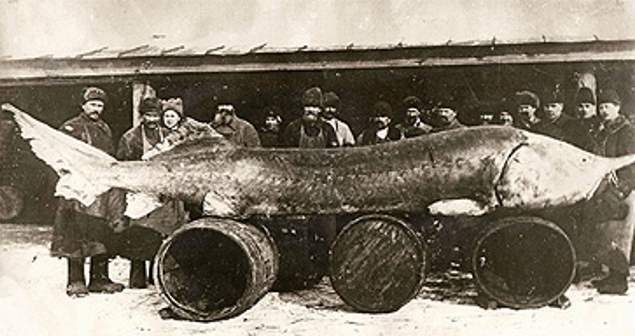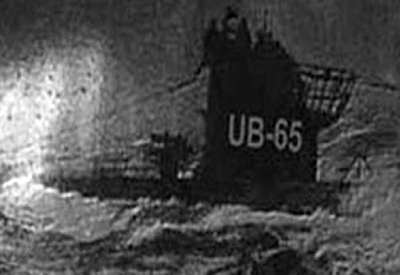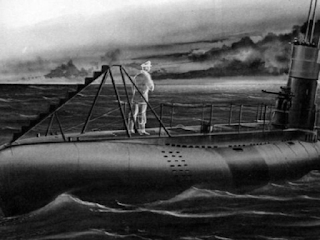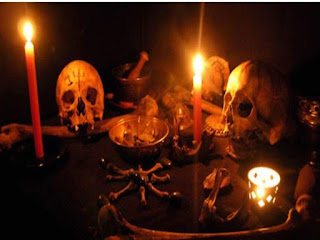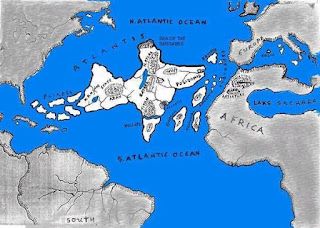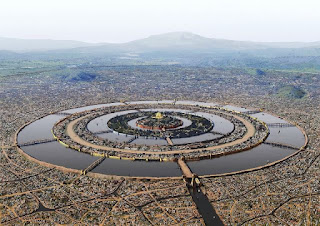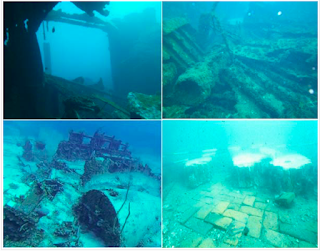The event took place in December 1956 and almost the entire world press wrote about it. Sailing around the world in their luxury yacht 'Laura Lee', James and Helen Bryan found themselves in the waters of the Pacific Ocean.
They had been sailing in the calm Pacific for days when, in the late twilight, on the far horizon, they saw the outlines of a small southern island. Although it was not marked on the ship's chart, this did not surprise the Bryans, because they knew that their ship's chart was not up to date. In addition, the area they sailed through was teeming with countless islets.
As night fell, they decided to drift off into the waters of this quiet Pacific island. That's why they steered the yacht in that direction. Soon they sailed into a small sandy cove, and as it seemed to them that the islet was uninhabited, they dropped anchor, deciding to explore the interior of the island tomorrow.
James Bryan tried in vain that night to identify the island. The islet was not registered on any of the nautical charts he used. He precisely recorded its position, deciding to report his discovery to the National Geographic Society in Washington so that it would be included in maritime atlases.
That night, James and Helen treated themselves to a little celebration. They dined on the deck of lobsters bought at the Vivak island market, with a candle and a bottle of sparkling wine, admiring the quiet southern night and the colorful islet on whose sandy beaches gentle sea waves foamed. As a gentle wind blew through their crowns, the tall palm trees bent slightly, obscuring the starry sky.
The Bryans went to bed that night filled with the pleasant feelings that come over people who discover a new home. Mrs. Helen woke up first. The sun had already risen and she lazily strolled out onto the deck to pick up a few towels that were drying. When she became aware that something was wrong, she paused in confusion. All around stretched a calm open sea and nowhere on the horizon was that quiet bay, nor the colorful island with tall palm trees that they had anchored by the day before.
Helen nearly screamed and woke James in a panic. But it was all in vain. All they could conclude was that their yacht had not changed its position during the night and that they were still at the place where they had dropped the ship's anchors. However, the colorful island was no longer there.
The second case is even more unusual. At the beginning of the twentieth century, during the rapid development of textile production and the great need for cotton, many American farmers decided to grow this industrial plant. However, the highest quality types of cotton required special conditions and produced the highest quality fruit on the southern islands.
Under pressure from interested farmers, the US government approached Japan with a request to lease several of its islands for cotton cultivation. A deal was soon made. Japan ceded three small Pacific islands. However, when the American farmers arrived at the given latitude and longitude, they were a little surprised, because they could not find the leased islands. There was no sign of land anywhere nearby!
An international scandal broke out, so Tokyo reacted quickly. He sent his fleet to determine if there really were leased islands or not, but the Japanese fleet did not find them either. The islands simply disappeared and no one could explain what happened!
Mysterious Island of the Seven Cities
On old nautical maps we find many islands drawn, which are not there today: Antilia, St. Brandan, Brazil, Friesland, the island of Seven Cities... and the stories about them are more than interesting.
When the Moors, under the leadership of General Tariq, broke into European soil in 711 and occupied present-day Spain and Portugal, legend says that seven Catholic bishops, led by the Archbishop of Oporto, who did not want to live under the rule of the conquerors, led a group of refugees , which boarded several ships and sailed west. The story goes that, after wandering, they landed on a larger, colorful island where they founded seven cities, which is how they named their new abode.
The island of the Seven Cities, however, has been the subject of controversy since that moment. In the following centuries, many navigators considered it phantom, and in the 12th century, the famous Arab geographer and cartographer Idrisi, wrote about an island in the Atlantic, called Bahelia, on which there once existed seven cities. However, that island disappeared after that and nothing was heard about it until the 14th and 15th centuries. Then, on the maps of Italian and Spanish navigators, in the western part of the Atlantic, the island of Antilles appears with seven cities with unusual names: Azai, Ari, Haisos, Anzuli, etc., and in 1474, King Alfonso V of Portugal presented Captain F. Teles with 'Seven cities and other islands in the Atlantic, north of Guinea'!
There is no doubt that in those years the island of the Seven Cities represented a real mystery. This is evidenced by the record of the Flemish sailor Ferdinand Dulmus, who in 1486 asked the Portuguese king for permission to take possession of that island if he found it at all, and in 1498 the Spanish ambassador to the English court, Pedro Ahal, informed his king that Bristol sailors had sent several expedition in search of the islands of the Seven Cities and Friesland, but they failed to find them!
It remains unclear whether and why some cartographers equated the island of the Seven Cities with Antillia. It is known that European geographers sincerely believed that Antilles existed. So in 1492, Martin Bechaem, on his famous globe, placed it in the Atlantic, noting that 'a Spanish ship sailed to its coast without any danger in 1914'!
Antalya was also mentioned by other cartographers of the 15th century, and in a letter to King Alfonso V in 1480, Columbus also mentioned it with the words "the island of Antilia, which is also known to you". The king even recommends Antillio to him "as a good place where he will stop on his voyage and land on the coast".
As far as is known, Columbus never landed there, because he did not find Antilles, but they were later named the Greater and Lesser Antilles after that phantom island!
The Legend of St. Brendan
Saint Brandan is a historical figure (484-577). During his long life he became a living legend. Traveling around the northern countries and islands, he spread Christianity and founded several monasteries. He was especially persistent in organizing expeditions, which searched for the Islands of the Happy, in the western Atlantic, which many still identify with the legendary Avalon, a kind of paradise on earth.
In the Irish epic 'Voyage of Saint Brandan', the missionary's exciting voyage to an unusual archipelago, 40 days' sailing away, is described. With 17 of his companions, priests, Saint Brandan landed on a colorful stone island from which waterfalls tumbled into the sea. There they found a guide with whom they landed on the island of Bird's Paradise, but soon they continued sailing and after a three-month journey through the fog, they reached the island where Saint Ailbe lived in a large monastery.
The Irish Odyssey, as it could be called 'The Voyages of St. Brandan', describes the time of several years, in which the famous missionary landed and visited an unknown number of picturesque islands, which today are not on any nautical chart of the Atlantic Ocean. They stayed on a wooded island full of vines, which they called Grape Island; rested on the Isle of Sheep; encountered icebergs and observed islands with volcanic domes. Eventually they reached the Promised Holy Land, a rich treasure of fruits and vegetables 'and all kinds of prosperity', where they spent seven happy years. Saint Brandan returned to Ireland in advanced years. He died soon after, reaching the age of 93.
A large geographical map of the world from 1275 still covers one entire wall in the cathedral in Hereford, England. The discoveries of St. Brandan were also registered on that map, so the 'Seven Holy Islands' - the islands of St. Branadana'. On later maps, these islands are mentioned less and less, and in the 18th century, the islands appear under the name Canaries. Among the inhabitants of those seven islands, it was believed that there was an eighth island, called Sv. Boronda, and that it is located about 40 nautical miles from the island of Palma. Several fishing expeditions searched for this island in 1721, but it was no longer in the indicated position! He was never heard from again!
Island of the Dead Souls
A legend still lives in Iceland today, which says that through a secret entrance on the Hekla volcano, you can reach the underground cities, where the descendants of an old, highly developed civilization still live. Those cities, according to that tradition, were built by the gods of the sea, who came from the heavens and were the undisputed rulers of the sea depths for centuries.
Many phantom islands are drawn on old maritime maps, but one is particularly interesting, which appeared and disappeared in different parts of the Atlantic Ocean in the past centuries. They called it - Breasil, Brezil or Brasil, and its existence was believed until the 19th century.
Phantom Island was first mentioned on Dulcert's map in 1325 and is located in waters south of Ireland. Later, it is referred to as an island surrounding a calm lagoon with nine islets, and since the 16th century Breasil has been 'walking' in the waters near North America, only to 'return' to its old place, south of Ireland, in the 18th century. .
The first organized search for the 'island that appears and disappears' was recorded in 1452, when the Portuguese navigator Diego de Teive was sent by Prince Henryk to circumnavigate the North Atlantic. In search of Breasil, the Portuguese sailor reached all the way to Irish waters, but did not find the island. The same fate was experienced by the famous Captain John Lloyd, 'the most famous sailor in all of England', who after nine weeks of unsuccessful search, exhausted, disappointed and defeated, returned to his native Bristol. At the end of the 15th century, several more expeditions were organized, but all were in vain - the island of Breasil simply disappeared!
The mysterious island is also mentioned in Irish legends. It is related to the old Celtic story of nine islands that rise out of the sea every seven years and disappear as soon as a ship approaches them.
Tradition says that there were several serious witnesses who allegedly saw with their own eyes when Breasil appeared from the depths of the sea. Stunned eyewitnesses, later, claimed that on the mysterious island they noticed some kind of human-like beings moving along the shore, so the pious people of that time believed that the souls of lost sailors lived on Breasil...
Hy-Brasil, the Hidden Island of Giant Magical Rabbits
In 1680, a story was recorded about how a certain Oly spent six or seven years on the island of Hi Brasil, and when he returned he was able to cure people of a wide variety of serious and incurable diseases, because, allegedly, during his stay on the mysterious island, he learned the art of magic and medicine! In the interesting part 'Irish poets, wanderers', it is stated that in 1636 a captain named Rich, who sailed from Dublin, 'managed to discover Brasil, but could not disembark because of thick fog'.
It is certain, however, that the only man who managed to land on this mysterious island was the Irish sailor, the vagabond John Nisbatt. Having sailed to Ireland in 1674, he said that Brasil was 'a great black rock, inhabited by black rabbits and a poor dangerous wizard, who lives in a great enchanted castle'. Nisbatt was able to resist the sorcerer's magic and escape thanks to the fact that he lit a fire, and fire, as it is known, represents the power of light in the fight against the forces of darkness. Breasil was dying slowly. It remained on some naval charts until the end of the 19th century. It was only at the end of 1873, when the navigators failed to provide any evidence of its existence, that the British Admiralty deleted it from all their maps forever.
But how could it happen that the stories about Breasil, the island 'that emerges from the sea and disappears', that is, a phantom island, captured the imagination of sailors and maritime superpowers for centuries? Where and why? Adequate answers have never been found to these questions.












